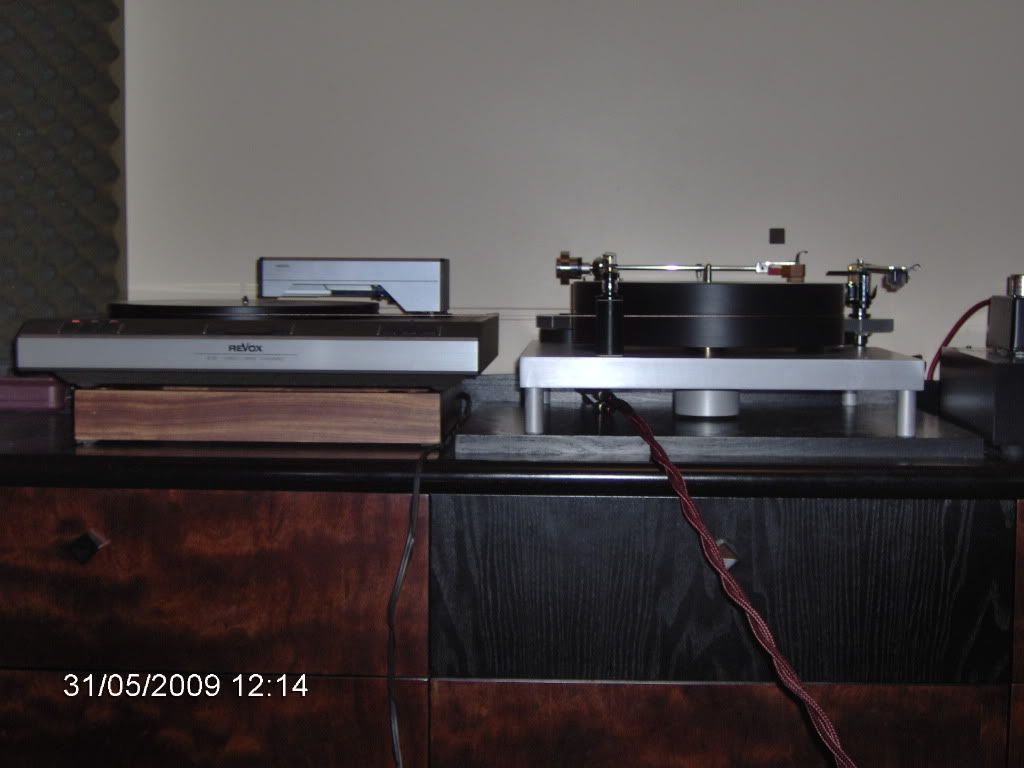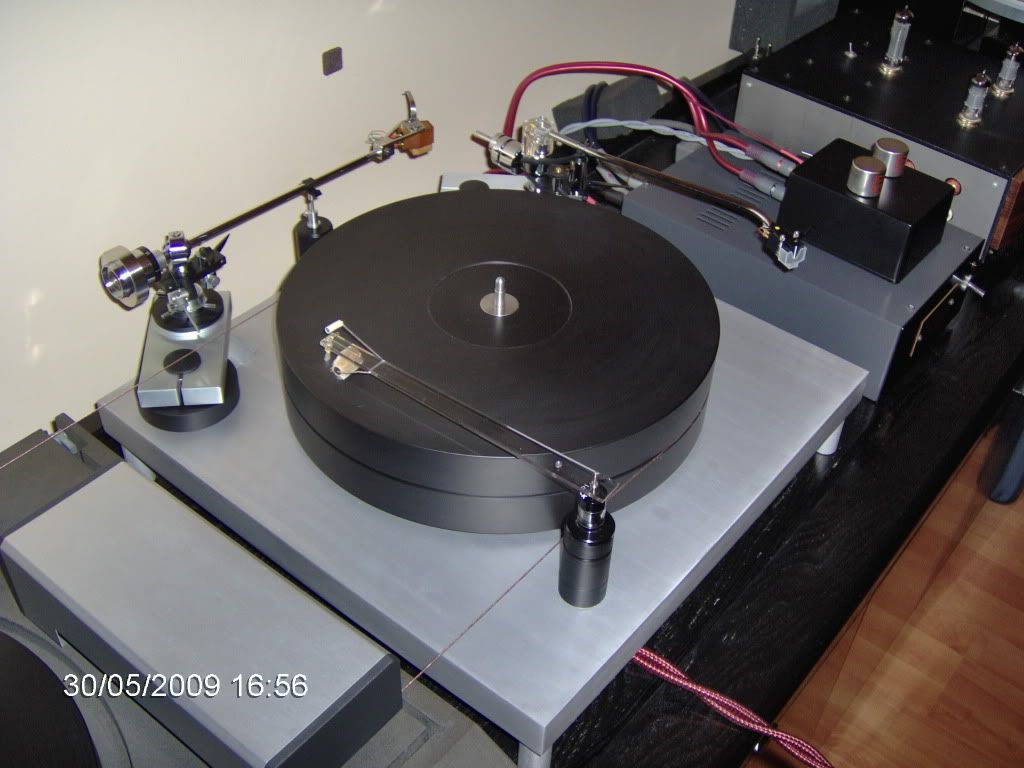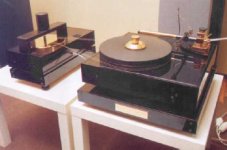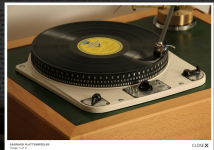The only thing you want movement from is the stylus and nothing else. Now while its more complicated than that, considering that to get there requires other " attached materials" in consideration, the first thing you want connected is a material that provides support and at the same time, not so soft to bend under weight, and if stimulated, can absorb and quietly scrub off any vibration that might get back to the stylus with at least a decent delay that gets absorbed as much as possible with out a recognizable signature.
All this talk about materials that are high Q and available in quantity get more traction because of their universal availability and thats the problem right there!
We need materials that are non invasive and dumb to outside indifference.
The substance I use is still solid acrylic 3/4" or more and it gets quite expensive and little attention from Mfgrs because of it.
The sandwich approach is the best compromise of dead influence and should be your last decision if unsure.
Regards
David
I agree, but the deciding criteria for diy-er and manufacturer may be different. The manufacturer wants to keep costs as low as possible and achieve a level of quality, whereas the diy-er wants as high a quality as possible for the money, although efficacy of design may be different in each case, too.
Availability of materials, locally, is of concern to diy-ers, and trying to achieve a design that can be built with just local materials is very difficult, even down to the names used.
The use of materials with high damping factors (low Q) is slowly being recognized by manufacturers, but even more slowly by diy-ers. This may be due to sourcing problems and problems with fabrication. For the moment, a cheap, easy to make design (that works) is not readily apparent, even ones that don't work are hard to fabricate for the most part. The design I am working on, ATM, has parts available mail order from suppliers in Europe, but will still cost upwards of £120 for materials alone, not including my own formulated damping compounds.
Acrylic, on its own, is not the best material, either. It only just gets into the 'damping material' category, with a damping factor of 0.07, easily bettered by many materials, although better than most of the usual suspects, like slate, plywood and Corian. However, in combination with other materials, and used as a composite, it can fulfil its intended role.
Last edited:
I like the look of this one :
Mono and Stereo High-End Audio Magazine: Air Tight Acoustic Masterpiece T-01 turntable
Mono and Stereo High-End Audio Magazine: Air Tight Acoustic Masterpiece T-01 turntable
My idea is to use the complete table and drive the "real" table via a string, belt, tape or whatever. So it is two tables side by side.
Hi Joachim!
Did that in the early eighties: A Garrard 401 driving a Thorens TD125 via a non-stretch thread. The subchassis-suspension of the TD125 provided the "tensioning force" for the thread.
Later used the same arrangement for a Garrard 301/501 combo. Twice the inertia, none of the motor/idler wheel noise... easy to try without having to build a deck from scratch. Candidates for "drivers" are plentiful: Rek-O-Kut and other broadcast idler wheel decks with loads of torque, but otherwise too noisy to use unless one rebuilds them from the ground up.
Keeping a fixed relation between drive unit and driven platter is still preferable, but harder to implement if one is looking for minimum noise transfer.
Cheers,
Frank
My idea is to use the complete table and drive the "real" table via a string, belt, tape or whatever. So it is two tables side by side.
I did something like that years ago. They're all direct-drive turntables using as a motor or active platter to drive another passive platter. Mostly using VHS tape as interface, sometimes dental floss. It's important to use low compliant material as belt so tape works well. I even used an idler wheel as interface but it was too fussy to set up but sounded good.






a member from Turkey did this:


One of the advantages of such an arrangement is the large contact area(between thread or tape to platter), so tape can be used without having to excert too much side force.
Best,
Frank
P.S.: Is that a DL103 in a Moerch UP4 arm? Unlikely combo....
Best,
Frank
P.S.: Is that a DL103 in a Moerch UP4 arm? Unlikely combo....
Is that a DL103 in a Moerch UP4 arm? Unlikely combo....
According to member hagustos' post, it is indeed a DL103.
.
a good number, and more in the pipeline. Many by others, too.
I feel an ad hominem argument coming on.
No need to get argumentative, I was merely wondering if your musings were purely speculation or if you had any experience of their application in the real world. I have little time for people's idle musings and value their practical experience much more.
Any chance you would like to share some pictures of them?
Last edited by a moderator:
No need to get argumentative, I was merely wondering if your musings were purely speculation or if you had any experience of their application in the real world. I have little time for people's idle musings and value their practical experience much more.
Any chance you would like to share some pictures of them?
why would you think mine are idle musings, what I have written is the same as in all good books on acoustics/vibrations, and in the scientific literature.
I've only built one turntable in the last couple of years due to house moving and unsuitable facilities, but I have been building and measuring parts for the last four and a half years, and continue to do so. Most the decks I have built have been before I bought a digital camera, so no pics of them.
Many audiophiles/music lovers have built plinths using the same principles, and reported good results. They are various forums for all to see, if you want pics.
Nice to find you here again Joao
Looking forward to meet you and listen to your TT 🙂
You are welcome and I look foreward to meet you here as well. Made some nice experiences with the solid state - transformer coupled - phono too - would be interesting for you.
I sent you a PM with my contact data.
The reason I ask is that there is plenty of info missing from your methodology. I also greatly doubt the applicability of testing a small tile sample as regards how these materials sound when built into a structure. Its a huge leap of faith to assume the results will correlate. My own research and manufacture of over 100 mineral, participate and short strand fiber reinforced composite test samples over a decade ago tell me this. The one that measured best didn't make the best speaker cabinet, the lowest panel vibration overall actually came a more dense sample.
But if you don't have any pictures and havent made the same deck twice in different materials I'll not trouble you any more.
But if you don't have any pictures and havent made the same deck twice in different materials I'll not trouble you any more.
Joachim
Cool, you are still using the Forsell you played in the High End shows in Kempinski ... Audio Physic times!
Cool, you are still using the Forsell you played in the High End shows in Kempinski ... Audio Physic times!
The reason I ask is that there is plenty of info missing from your methodology. I also greatly doubt the applicability of testing a small tile sample as regards how these materials sound when built into a structure. Its a huge leap of faith to assume the results will correlate. My own research and manufacture of over 100 mineral, participate and short strand fiber reinforced composite test samples over a decade ago tell me this. The one that measured best didn't make the best speaker cabinet, the lowest panel vibration overall actually came a more dense sample.
But if you don't have any pictures and haven't made the same deck twice in different materials I'll not trouble you any more.
Would you care to mention the methodology that you think is missing? I measure mostly the damping factor of materials, and look at the vibrations of composites. Damping factor is an intrinsic property, and does not vary (much!) with the size of the test piece, much like density. According to ASTM testing methods, test pieces should have a length to thickness ratio of 10:1, (or greater), and the mass of the test piece should be more than 40x that of the transducer.
When built into a structure, properties will most likely change, as the material has changed and the method of mounting may be different, but as a guide to choosing the appropriate material in the first place, it is a good place to start. It certainly doesn't take 100 different tests to realize which materials will be fit for purpose, and those that won't.
Just because I haven't made a 100 turntable plinths, doesn't mean to say I haven't the right to express my experiences, or invalidate my results.
I knew this was going to be an ad hominem argument. If you don't believe me, then read some books on the subject. Although 3 months in the workshop could save you a whole morning in the library. 😱
Guys, cool down please. I appreciate your contribution though.
No, i do not use the big Forsell any more.
Have not fired it up for several years.
Maintaining 3 pumps, a floating flywheel, a floating platter and a floating arm is just to much.
WHEN it played it sounded very good but the noise can not be brought down to zero and there where speed stability issues that could not be solved 100%.
The air hoses of the arm have to be meticulous clean, etc.
No, i do not use the big Forsell any more.
Have not fired it up for several years.
Maintaining 3 pumps, a floating flywheel, a floating platter and a floating arm is just to much.
WHEN it played it sounded very good but the noise can not be brought down to zero and there where speed stability issues that could not be solved 100%.
The air hoses of the arm have to be meticulous clean, etc.
cats squirrel,
I wouldn't argue with your testing and general knowledge of a materials damping properties but I will add that they will change significantly in a constrained state rather than in an unconstrained test setup. When you take any material and turn it into a complex shape with various attachment and shapes other than flat things can change rather abruptly in their properties. I understand that a plinth is normally a simple flat shape, but do not take that information and think that those same materials used in other applications will follow the same results that you would get from an unconstrained simple flat panel.
I wouldn't argue with your testing and general knowledge of a materials damping properties but I will add that they will change significantly in a constrained state rather than in an unconstrained test setup. When you take any material and turn it into a complex shape with various attachment and shapes other than flat things can change rather abruptly in their properties. I understand that a plinth is normally a simple flat shape, but do not take that information and think that those same materials used in other applications will follow the same results that you would get from an unconstrained simple flat panel.
I understand all that. My 'musings' are along the lines of flat isotropic or sandwich composite panels (or plates) unconstrained and simply supported, because that is how I make plinths, and I believe that is all that is necessary, even desirable. More complex designs introduce more complex problems, so why complicate matters.
The mechanics of flat isotropic panels is well understood (by academics and practical engineers alike) so these are not fanciful musings, the principles have been known for decades, some of it for over a century. What is relatively new is the work being done on composites.
Anyone can knock up a very decent plinth by taking a panel of suitable material and knocking a few holes in it to accommodate the turntable (and arm). The key word here is 'suitable', most materials chosen for plinth (or shelf or loudspeaker panel) duty are not very suitable, and most are not suitable at all.🙂
The mechanics of flat isotropic panels is well understood (by academics and practical engineers alike) so these are not fanciful musings, the principles have been known for decades, some of it for over a century. What is relatively new is the work being done on composites.
Anyone can knock up a very decent plinth by taking a panel of suitable material and knocking a few holes in it to accommodate the turntable (and arm). The key word here is 'suitable', most materials chosen for plinth (or shelf or loudspeaker panel) duty are not very suitable, and most are not suitable at all.🙂
- Status
- Not open for further replies.
- Home
- Source & Line
- Analogue Source
- The Good Turntable

